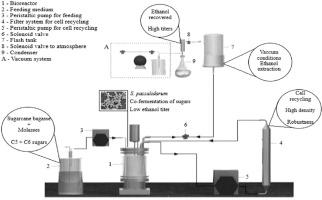Our official English website, www.x-mol.net, welcomes your
feedback! (Note: you will need to create a separate account there.)
Sequential fed batch extractive fermentation for enhanced bioethanol production using recycled Spathaspora passalidarum and mixed sugar composition
Fuel ( IF 6.7 ) Pub Date : 2021-03-01 , DOI: 10.1016/j.fuel.2020.119673 D. Farias , F. Maugeri-Filho
Fuel ( IF 6.7 ) Pub Date : 2021-03-01 , DOI: 10.1016/j.fuel.2020.119673 D. Farias , F. Maugeri-Filho

|
Abstract The simultaneous ethanol production and removal during sequential cell recycle fed batch fermentation provides a complementary route to produce this biofuel from sugar mixtures, which may greatly improve yields and productivity from lignocellulosic hydrolysates. Spathaspora passalidarum is a wild-type strain able to naturally convert glucose, fructose, xylose and arabinose into ethanol. Therefore, the present work has focused on 2G bioethanol production by S. passalidarum aiming at the consumption of all sugars released after pre-treatment and enzymatic hydrolysis of sugarcane bagasse in a single fermentation step. The fermentation strategy with sequential cell recycle, fed-batch mode and ethanol removal in situ was performed on a hemicellulosic hydrolysate medium supplemented with molasses. This strategy gave improved fermentation performance and enabled the co-fermention of all sugars under microaerobic conditions. The maximum ethanol yield and productivity was 0.482 g.g−1 and 9.5 g·L-1·h−1, respectively, showing a process efficiency of 94.3%. The selective ethanol removal enables the operation of the bioreactor at low levels of ethanol (20–30 g·L-1), even with high sugar concentration inputs, accelerating the fermentation performance and avoiding inhibitory effects on yeast metabolism. Applying the cell recycle strategy, S. passalidarum was able to increase its robustness, as shown by a 10-fold increase in ethanol productivity, and it was also able to tolerate a high acetic acid concentration (4.5 g·L-1) during long-term fermentations. These results demonstrate that the bioprocess strategy has a strong potential to improve bioethanol production of rich mixed sugar from lignocellulosic hydrolysates in a single fermentation step.
中文翻译:

使用回收的 Spathaspora passalidarum 和混合糖组合物进行连续补料分批提取发酵以提高生物乙醇产量
摘要 在连续细胞循环补料分批发酵过程中同时生产和去除乙醇提供了从糖混合物生产这种生物燃料的补充途径,这可以大大提高木质纤维素水解物的产量和生产力。Spathaspora passalidarum 是一种野生型菌株,能够自然地将葡萄糖、果糖、木糖和阿拉伯糖转化为乙醇。因此,目前的工作重点是通过 S. passalidarum 生产 2G 生物乙醇,旨在消耗在单个发酵步骤中甘蔗渣预处理和酶水解后释放的所有糖。在补充有糖蜜的半纤维素水解产物培养基上进行具有顺序细胞循环、补料分批模式和原位去除乙醇的发酵策略。该策略提高了发酵性能,并能够在微需氧条件下共同发酵所有糖类。乙醇的最大产量和生产率分别为 0.482 gg-1 和 9.5 g·L-1·h-1,表明工艺效率为 94.3%。选择性乙醇去除使生物反应器能够在低乙醇水平 (20–30 g·L-1) 下运行,即使是高糖浓度输入,加速发酵性能并避免对酵母代谢的抑制作用。应用细胞回收策略,S. passalidarum 能够提高其稳健性,如乙醇生产率提高 10 倍所示,并且它还能够在长时间内耐受高浓度的乙酸 (4.5 g·L-1)。 - 长期发酵。
更新日期:2021-03-01
中文翻译:

使用回收的 Spathaspora passalidarum 和混合糖组合物进行连续补料分批提取发酵以提高生物乙醇产量
摘要 在连续细胞循环补料分批发酵过程中同时生产和去除乙醇提供了从糖混合物生产这种生物燃料的补充途径,这可以大大提高木质纤维素水解物的产量和生产力。Spathaspora passalidarum 是一种野生型菌株,能够自然地将葡萄糖、果糖、木糖和阿拉伯糖转化为乙醇。因此,目前的工作重点是通过 S. passalidarum 生产 2G 生物乙醇,旨在消耗在单个发酵步骤中甘蔗渣预处理和酶水解后释放的所有糖。在补充有糖蜜的半纤维素水解产物培养基上进行具有顺序细胞循环、补料分批模式和原位去除乙醇的发酵策略。该策略提高了发酵性能,并能够在微需氧条件下共同发酵所有糖类。乙醇的最大产量和生产率分别为 0.482 gg-1 和 9.5 g·L-1·h-1,表明工艺效率为 94.3%。选择性乙醇去除使生物反应器能够在低乙醇水平 (20–30 g·L-1) 下运行,即使是高糖浓度输入,加速发酵性能并避免对酵母代谢的抑制作用。应用细胞回收策略,S. passalidarum 能够提高其稳健性,如乙醇生产率提高 10 倍所示,并且它还能够在长时间内耐受高浓度的乙酸 (4.5 g·L-1)。 - 长期发酵。









































 京公网安备 11010802027423号
京公网安备 11010802027423号